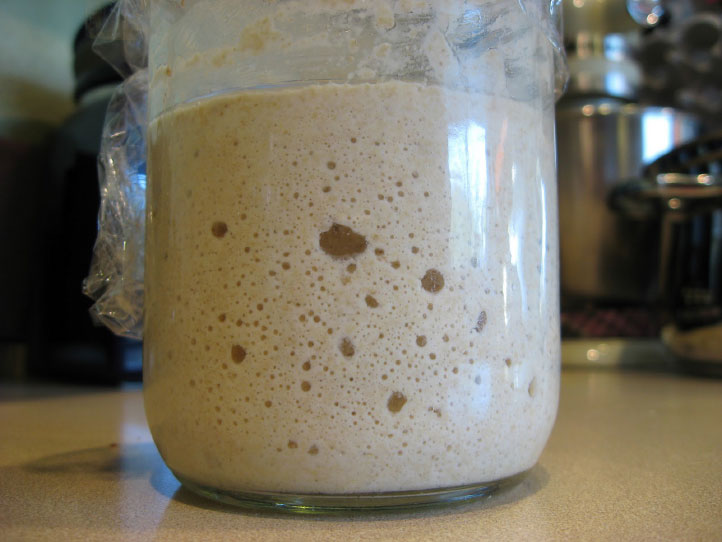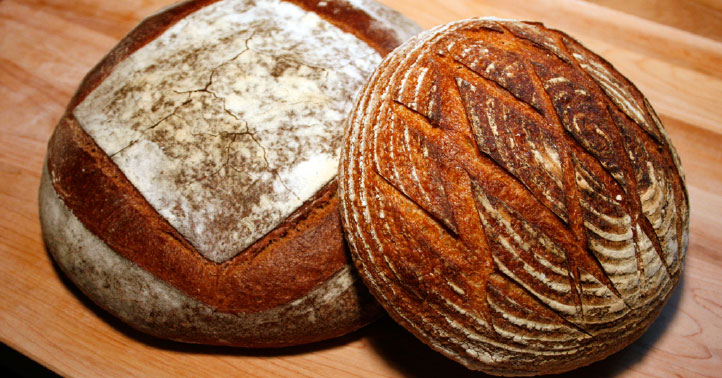How to Make and Maintain Sourdough Starter

There are some wonderful sourdough recipes in this issue of the magazine. You can purchase sourdough starter from a variety of sources. My first starter came from a site called Breadtopia.com. I have no affiliation with them, but the site owner has some outstanding resources, items, and recipes, including some fabulous no-knead bread recipes. I’ve made the no-knead sourdough bread, and it is phenomenal.
I thought I would share with you how to make your own sourdough starter, adapted from Breadtopia. This recipe contains pineapple juice and wheat for those who are allergic to these items.
Ingredients:
- Unsweetened pineapple juice (fresh or canned, no sugar added)
- Flour (you can use white, whole wheat, or rye, depending on what kind of starter you would like to make).
- Purified water (I keep a gallon jug of water used to mix baby formula that you pick up in the beverage section of grocery store)
- A large jar or other container with a loose lid (a tight lid will prevent the sourdough bacteria and yeast from getting enough oxygen). I sometimes use just plastic wrap on top of the jar.
Day One:
- Mix 3 ½ tablespoons of flour with ¼ cup unsweetened pineapple juice.
- Cover and set aside for 48 hours at room temperature.
- Stir vigorously (a whisk helps) 2 or 3 times a day. You may not see bubbling for awhile.
Day Three:
- Add to the above mix 2 more tablespoons of flour and 2 tablespoons pineapple juice.
Cover and set aside for another one to two days. - Stir vigorously 2 or 3 times a day. You should see some fermentation (bubbling) by the end of day five.
Day Five:
If you do not see bubbling:
- Toss it out and start over.
If you do see bubbling:
- Add 5 ¼ tablespoons flour and 3 tablespoons purified water and mix well.
Cover and set aside for 24 more hours.
Day Six:
- Add ½ cup of flour and 1/3 cup of purified water.
Your sourdough should be nice and healthy now. At this point, you may start using it. If you are not going to feed your sourdough daily, store it covered in the refrigerator.
To maintain your starter:
You need to feed your starter regularly. If you keep it at room temperature, feed it daily to prevent mold growth. If you keep it in the refrigerator, weekly feedings work well. I usually feed mine in the morning when I know I’m going to start some dough later in the day. That gets the fermentation really moving along.
When you feed your starter, it needs the same weight, rather than volume,of flour and water. That means you’ll use about ¾ cup of purified water for every cup of flour.
Ideally, you want to double the amount of starter you have currently. So, if you have 1/2 cup of starter, the most flour you’ll want to add is ½ cup (and 1/3 cup water). If you have 1 cup of starter, add 1 cup of flour and ¾ cup water. Now, if you already have 2 cups of starter, you might not want to double that to 4 cups if you don’t need that much. In that case, mix up the starter you already have, pour off 1 cup into the sink and keep 1 cup in the jar, and then feed the starter with 1 cup of flour and ¾ cup of purified water.
If your starter has been sitting in the refrigerator for a while, you’ll notice some liquid on top. That’s the ‘hooch’, or alcohol, created by your starter. Mix it right on into the starter before you feed it. I do not recommend drinking it!
Enjoy your starter in pancakes, bread, waffles, English muffins, cinnamon rolls, and any other place where you might use yeast. Usually, ¼ cup of starter can be used in place of a package or 2 ¼ teaspoons of dry yeast. You’ll need to give your sourdough extra time to rise—overnight works best much of the time. Have fun experimenting!

